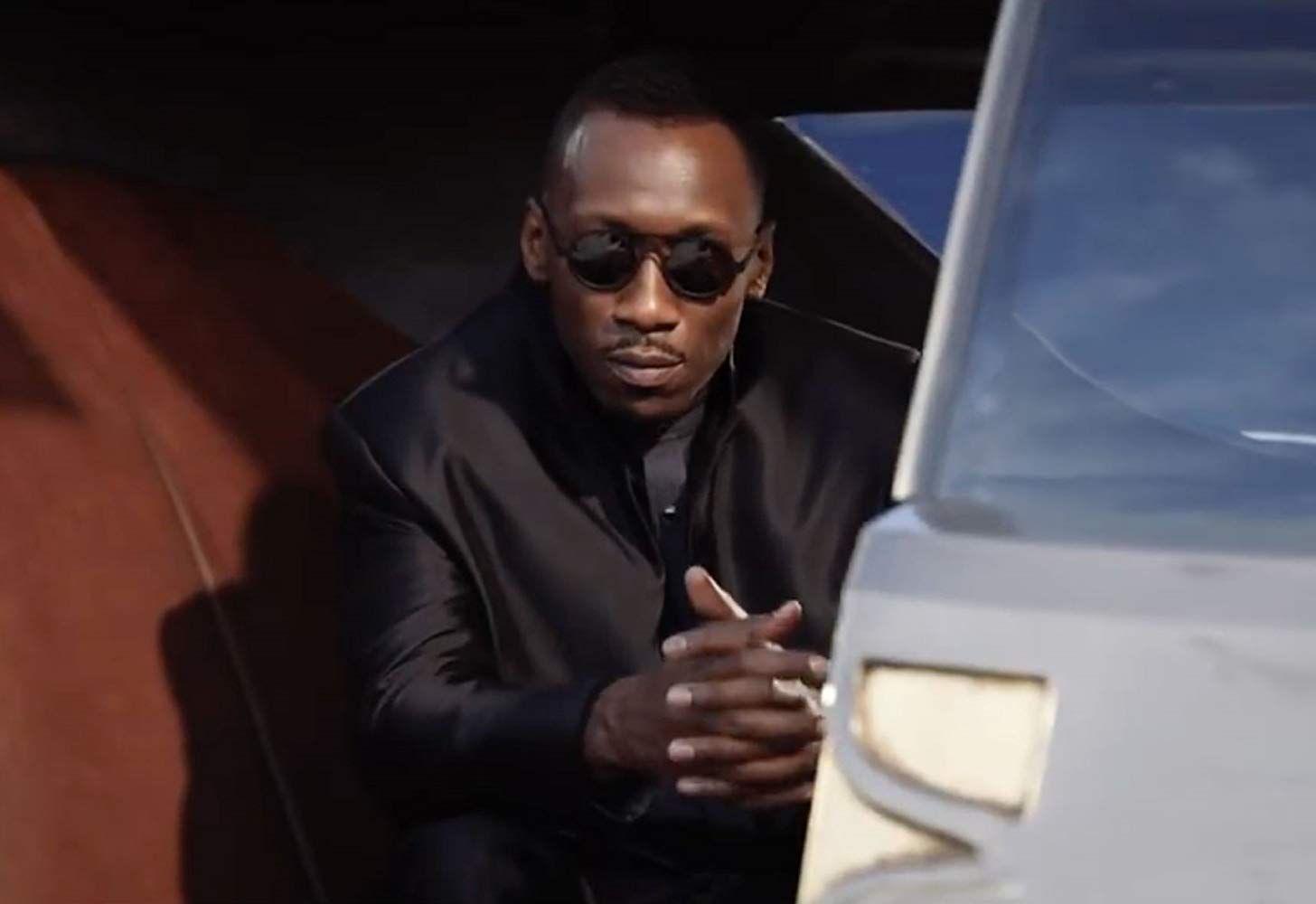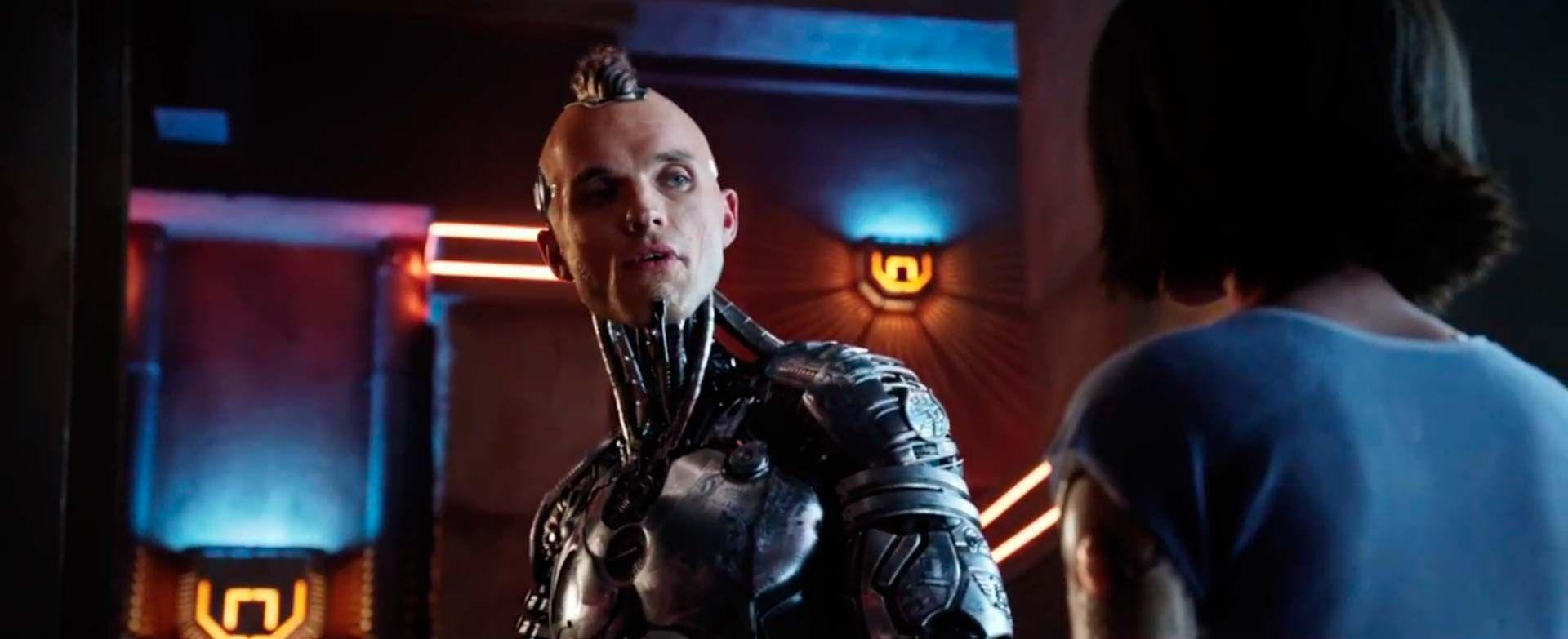

Blockbuster adaptations based on anime and manga don’t have the best track record. Seriously, try to think of one good Western adaptation of a manga or anime that wasn’t either a commercial or critical disappointment. And yet, Hollywood keeps returning to this genre, hoping to find the One Adaptation to Rule Them All.
Could Alita: Battle Angel, in theaters this weekend, be the first movie to break the curse? It certainly has the pedigree: It’s based on Yukito Kishiro’s manga series Gunnm, James Cameron is a cowriter and producer, and its director is Robert Rodriguez, a mercurial filmmaker whose action movies range from really good (Spy Kids!) to kill it with fire bad (The Adventures of Sharkboy and Lavagirl). The trailers, meanwhile, haven’t firmly indicated where Alita would land between those two poles, with exciting shots of Mahershala Ali as a villain interspersed with near-haunting close-ups of Alita’s giant eyes.
After seeing it, I can now affirm that Alita ends up … somewhere in the middle? The movie has some great things going for it: The action is phenomenal, and, unlike most CGI-heavy blockbusters, you can follow it easily. The cyberpunk-heavy world-building also leaves you yearning for more. Unfortunately, Alita devotes a disconcertingly large amount of time to a derivative and eyeroll-inducing teen love story that feels like it was plucked out of a run-of-the-mill YA novel.
But more than anything, Alita is weird as hell, man. As in, there’s a ton of graphic dismemberments, the future society revolves around a gnarly deathsport that has a lot in common with roller derby, and there’s a Big Movie Star cameo right before the end credits that must be seen to be believed. And also, Alita’s eyes. Watching the wildness unfold, you’ll definitely have plenty more questions than answers—just like I did.
1. Before we even get to any Alita footage: How’s the 20th Century Fox logo doing? This may seem like a dumb question, but this is a foundational component of any movie 20th Century Fox makes that takes place in the future or is set in a dystopia: The studio’s logo will be altered in some way to remind viewers that you’re in for a ride, that this ain’t no regular ol’ movie, and that shit is about to go down.
True to form, Alita opens with the 20th Century Fox logo transforming into a 26th Century Fox logo, because the movie takes place in the year 2563. The studio’s logo, once a shining beacon of flashy lights, is now damp, dark, and decrepit—it looks like Ridley Scott meddled with it in the most dystopian possible way. Yes, folks, shit is about to go down.
2. It doesn’t take long for us to be introduced to Alita (played by Rosa Salazar), whose cyborg head is found in a junkyard by robo-scientist Dyson Ido (Christoph Waltz) as he’s scavenging for parts dumped from the sky city called Zalem. In this future, Zalem is the apparent home to the rich and powerful, the final sky city on Earth that survived a cataclysmic event called “The Fall.” The rest of humanity lives in the cyberpunk favelas of Iron City.
That’s all well and good, but you’re probably wondering: How are Alita’s gigantic-ass eyes? It’s her eyes that have been, if not Alita’s selling point, its biggest source of fascination. (Alita has inspired my Ringer colleague Mose Bergmann to create horrifying mashups like “Aminu: Battle Angel,” which I have since flagged with HR.)
Here’s the thing: Alita’s eyes aren’t as distracting as you’d think. They’re certainly off-putting in a two-minute trailer because you barely have time to process what happened to her face before it’s over. But while Alita’s eyes definitely reach the uncanny valley, over the course of a movie that is two-plus hours long, you forget about them—if only because there’s so much other weird stuff to pay attention to.
That said, if you do fixate on Alita’s eyes sans context, then yes, they remain extremely strange.

3. Now that Alita’s gigantic eyes are out of the way, let’s focus on her love interest in the film, Hugo (Keean Johnson). Hugo is a local kid who is, conveniently, buddies with Ido, so it doesn’t take long for Hugo and Alita to meet and lock eyes. (His eyes are normal-sized.) But immediately, I thought to myself: Is this romance even appropriate?
As a cyborg-soldier, Alita has apparently existed for centuries—as Ido explains, she’s made out of technology that essentially went extinct after The Fall. But Alita herself has no memory of anything from her previous life. Every single thing she does, including eating an orange and a piece of chocolate, is a brand-new discovery. She has a childlike sense of wonder for the world around her, and, by all accounts, is literally living through the first day of her life. So I ask again: Is this appropriate? Should Alita really be worried about her love life right now? And what does it say about Hugo that he’s so eager to hit on a cyborg who was literally just born? For that matter, what does it say about Ido that he isn’t all that concerned about Alita dating mere moments after regaining consciousness?
I’m all for falling in love when the time is right, but I think “first boyfriend” probably shouldn’t coincide with “discovers what chocolate tastes like.”
4. Hugo is good for something, though, and that’s teaching Alita about the wonders of Motorball. What is Motorball? Well, how much time do you have?
Motorball is like a demented cross between Death Race, roller derby, and the Mad Max Thunderdome. It’s a race that takes place in a giant sports arena overseen by Cyberpunk Sports Mogul Mahershala Ali (no, seriously), with cybernetically enhanced contestants racing to pick up a metal ball and take it across the finish line. Contestants can be swole and full of brute force—all the better to beat the crap out of other fighters, this is a contact sport—or swift and agile. Kids like Hugo play it on the street because, if you become a Motorball champion, after a certain point you’ll supposedly be permitted into the hallowed sky gates of Zalem. (Nobody has survived the races long enough to find out, it seems. At the same time, it doesn’t appear anyone has had the IQ to wonder whether this promise of Zalem is an empty one.)
Alita is a natural at Motorball, and I can’t stress this enough: Motorball is crucial to the plot. Several of the film’s fight scenes are also Motorball racing scenes. In other words, Alita is basically Whip It crossed with Blade Runner—and it rules. Like the movie’s Motorball attendees, you can’t help but find yourself cheering when Alita uses Motorball’s, uh, motorball, to decapitate an opponent.
5. Would Motorball be my favorite sport if it were a real thing? Yes. I love soccer, but Neymar’s never strapping on rollerblades to chase a metal ball. I’m all in on Motorball. Sign me up for a subscription to Motorball pay-per-view.
6. I can’t believe it’s taken me this long to ask this, but really, what is Mahershala Ali doing here? I wish I had an answer. His character, Vector, is a paper-thin villain who stole his wardrobe from The Matrix franchise and is merely a pawn in a larger conspiracy being devised from afar by a nefarious scientist named Nova (oh, just you wait until we get to this guy’s identity). Nova, who lives on Zalem, can even transfer his consciousness into Vector during pivotal moments, rendering the character even more useless—though it does allow Ali to essentially play two different villains in the same movie.
Alas, both Vector and Nova-as-Vector have very little screen time, and considering Ali’s well on his way to winning a second Oscar this month, his secondary role in Alita feels like a missed opportunity for everyone involved. I just hope Ali got to keep his character’s dope sunglasses as some kind of Alita royalty. He might be the only person who could pull them off.

7. As the existence of an über-popular sport like Motorball would imply, Alita is far from the only character whose body has undergone significant robotic modifications. What are some of the wildest cybernetic enhancements in Alita?
A lot of characters we meet are “hunter-warriors,” bounty hunters who serve as the only type of law enforcement in Iron City. (Alita quickly becomes one herself.) Apparently, to defeat assassins and other criminals—who also have cybernetic enhancements—people will undergo some serious physiological changes. Perhaps the single biggest one in the film belongs to Zapan (Ed Skrein), a bounty hunter whose entire body is a robo-weapon—save for his face, which he wants to keep as handsome as possible. (He’s kind of a pretentious dick.) No offense, Zapan, but when the rest of your body looks like a glorified Gillette shaver, I don’t think people will be like, “But, man, check out those perfectly trimmed eyebrows!”

The other noteworthy hunter-warrior with a memorable aesthetic is McTeague (Jeff Fahey), an old-fashioned, cowboy-type character who uses a pack of robot dogs (!!) to hunt people.
8. Does this sound like a normal movie? It felt relatively straightforward when I was in the theater, but putting this all down on paper gives me second thoughts.
9. Is McTeague—a.k.a. Robot Dog the Bounty Hunter—my favorite character in Alita? Um, YES. I wish him and his robo-boys were around for more than 10 minutes. McTeague’s adorable yet lethal robot dogs look like early contenders for several awards at the 2020 Dog Oscars.
10. Because so many characters in Alita are made of cybernetic parts, the film is able to get away with a lot of intense violence that might’ve been a bit excessive if the characters were leaking blood instead of oil and cyborg goo. I can’t stress this enough: There are several characters in Alita whose limbs are severed from their bodies; many robo-decapitations occur; and there’s a flashback sequence involving a giant security thresher that slices cybernetically enhanced soldiers apart like a sushi chef making sashimi in a Wes Anderson film.
It goes to another level in the last act of the movie, when one regular human character is bisected, another is decapitated with the intent of attaching the head to a cyborg body, and another is killed off-screen—and we then see their individual organs being harvested for use in Zalem. I knew going in that Alita would be violent—and while I don’t have a problem with any of this, you have to wonder: How in the hell is this movie only rated PG-13?
11. If that’s not enough, I have some awful news to share: There is a also regular, non-robot dog in Alita, and it meets an unnecessarily gruesome end. This dog—which Alita befriends the same day she learns about the wonders of chocolate and finds out that boys are cute—is hanging out with McTeague (he’s really great) at the local hunter-warrior bar (a thing in this movie) when the place is attacked by Grewishka, a giant, evil cyborg who works for Nova and has the swollen face of Jackie Earle Haley. (It’s probably not a good idea to have one bar in the city serve as hunter-warrior HQ. Sort of makes all of them an easy target for criminals—but hey, I don’t have a steel sword for an arm, so what do I know?)
Grewishka is there to attack Alita, and before anyone can do anything, the little dog barks at him—and then Grewishka MURDERS THE DOG. It happens off screen, mind you, but that doesn’t make it any easier to swallow. To make matters worse—well, not necessarily worse, but definitely stranger—Alita dips her fingers in the dead dog’s blood and puts streaks of it under her eyes like war paint before she avenges his death.
Look, I appreciate the whole “revenge for dead dog,” John Wick–lite angle the movie was going for, but was any of this necessary? I was already rooting for Alita to kick Grewishka’s ass—I didn’t need her to rummage around the lifeless corpse of an innocent animal in order to get some cool face paint.
12. All of this fighting and Motorball-ing awakens something in Alita, who starts getting fragmented memories of her former life. (Spoilers ahead!) Turns out, Alita was formerly a cyborg warrior from Mars, one of many super-soldiers responsible for The Fall on Earth. She is literally out of this world, and we get a brief flashback of Alita and fellow “Battle Angel” Gelda (Michelle Rodriguez) fighting on the surface of the moon. Yes, that’s right: There’s a goddamn moon battle.
But we get only a fleeting moment of this moon-fight flashback, which begs the question: Who was it behind Alita that thought we wanted just 15 seconds of moon battle? Why couldn’t we get more moon fighting? Did they run out of moon-fight money in the budget? And how did they get Michelle Rodriguez for these relatively thankless flashbacks?
I genuinely love Motorball as much as the next guy—be sure to check out The Ringer next week for my Five Cyborgs to Watch in the Motorball Playoffs preview blog—but I’d have given up one Motorball sequence for a fully fleshed out battle on the surface of the moon. If Alita is blessed with a sequel, the powers that be should amend this egregious, lunar-related error.
13. Would all blockbusters benefit from a giant moon battle? Yes.
14. Does this also mean humans in 2563 live on Mars? Apparently, and it would also be great if an Alita sequel gave us a taste of the Martian life. If this franchise makes a seamless transition from Blade Runner roller derby to space battles (just don’t call it a star war), I’ll be willing to forgive James Cameron for his trash opinions about Aquaman.
15. Checking back in with the Alita and Hugo romance: They tend to stare at each other a lot—he says “you’re the most human person I’ve ever met,” which is just a bold-faced lie.
Hugo is trying to make enough money working for Vector—what he doesn’t tell Alita is that he makes cash by stripping cyborgs of their parts—to be sent up to Zalem. Alita, unaware of his seedy hustle and completely head-over-heels for the guy she just met, offers him her literal heart to get him over his financial hurdle. (She can survive without it, but you know, it’s still a vital part of her body.)
Seriously, the film with the badass female protagonist has her make a very unsubtle gesture of love for the dude she just met? Who thought this was a good look? There’s much easier ways to express that Alita cares for her boo than Hugo, my heart is literally yours. Thankfully, Hugo doesn’t accept it, probably because he harbors guilt about hunting her cyborg kind. As well he should.
Warning: This is where I dive into some serious spoiler territory, so if you don’t want a vague idea of how this film ends, or the identity of the Big Movie Star cameo, stop right here.
16. Alita, having defeated Nova’s henchmen Vector and Grewishka, sets her sights on gaining admittance to Zalem to stop the evil scientist, who’s doing something with human organs that’s extending his life in perpetuity. How, exactly, is Alita going to do that? Win a ton of Motorball matches, of course.
The film ends with a brief time-jump, after which Alita emerges victorious on the Motorball battlefield and points her sword toward Zalem, knowing that Nova has eyes everywhere and is always watching. That’s when we zoom toward Zalem and Nova puts down his binoculars, so that we can finally see what he looks like. And I’m not lying, it’s Edward freaking Norton wearing a tacky all-white suit and sporting a greasy white wig. He stops just short of letting out a Scooby-Doo supervillain cackle. (It was at this point that my theater gasped in horror or amazement, or maybe both.) Norton looks absurd—on par with Johnny Depp’s washed Grindelwald cameo at the end of the first Fantastic Beasts movie.
It is also, of course, a huge flex on Alita’s part that everyone involved is very confident this blockbuster will make enough money to warrant a sequel, where Norton would ostensibly get significantly more screen time. Given the film’s early box office projections, however, we might be thinking more about what could’ve been with Nova Norton. The future of this franchise might depend on how well Alita performs overseas.
17. Now, would I watch an Alita sequel? It’s by no means a perfect blockbuster, but Alita has distinctive cyberpunk visuals, thrilling fight scenes, and a charming, soulful lead performance from Salazar that should be remembered for more than just her big CGI eyes. Without a second thought—and greasy white-wigged Ed Norton or not—I’d be the first in line for Alita: Battle Angel 2—Lunar Motorball Thunderdome. American moviegoing public, let’s make this happen.

